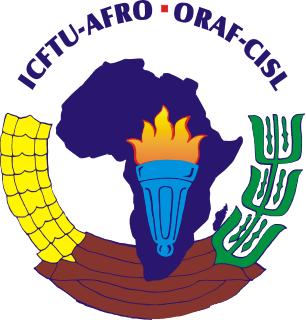
The International Confederation of Free Trade Unions (ICFTU) was an international trade union. It came into being on 7 December 1949 following a split within the World Federation of Trade Unions (WFTU), and was dissolved on 31 October 2006 when it merged with the World Confederation of Labour (WCL) to form the International Trade Union Confederation (ITUC).

The World Federation of Trade Unions (WFTU) is an international federation of trade unions. WFTU was established in 1945 to replace the International Federation of Trade Unions. Its mission was to bring together trade unions across the world in a single international organization, much like the United Nations. After a number of Western trade unions left it in 1949, as a result of disputes over support for the Marshall Plan, to form the International Confederation of Free Trade Unions, the WFTU was made up primarily of unions affiliated with or allegedly sympathetic to communist parties. In the context of the Cold War, the WFTU was often portrayed in the West as a Soviet front organization. A number of those unions, including those from Yugoslavia and China, left later when their governments had ideological differences with the Soviet Union.

The World Confederation of Labour (WCL) was an international labour organization founded in 1920 and based in Europe. Totalitarian governments of the 1930s repressed the federation and imprisoned many of its leaders, limiting operations until the end of World War II. In 2006 it became part of the International Trade Union Confederation (ITUC), ending its existence as an independent organization.

The International Federation of Building and Wood Workers (IFBWW) was a global union federation of trade unions in the building, building materials, wood, forestry and allied industries.

The International Textile, Garment and Leather Workers' Federation (ITGLWF) was a global union federation. In 2005 it had 217 member organizations in 110 countries, representing a combined membership of over 10 million workers.
The ITUC Regional Organisation for Asia and Pacific is a regional organisation of the International Trade Union Confederation representing trade unions from countries in Asia and Oceania. It has 40 affiliated organisations in 28 countries, claiming a membership of 30 million people.

The Trade Union Confederation of the Americas (TUCA-CSA) is the regional organization of the International Trade Union Confederation for the Americas.
The International Federation Textile-Clothing (IFTC/FITH) was an International Trade Federation of the World Confederation of Labour (WCL).
The International Federation of Employees in Public Service was an International Trade Federation of the World Confederation of Labour (WCL).
The Confederation des Travailleurs Haïtiens (CTH) was founded in 1998 to provide a space for Haitian workers to organize collectively and promote a progressive agenda, such as opposing the privatization plans of international financial institutions. Trade unionists of the CTH are based in numerous professions, such as education, artisan work, informal sector, port authority, transportation, and as pastors working in rural areas with church coalitions. They have two offices in Port-au-Prince and one office in each of Haiti's ten departments.

The International Trade Union Confederation is the world's largest trade union federation.

The ICFTU African Regional Organisation (AFRO) was a regional organisation of the International Confederation of Free Trade Unions (ICFTU), representing trade unions from countries in Africa.

The ICFTU Asia and Pacific Regional Organisation (APRO) was a regional organisation of the International Confederation of Free Trade Unions (ICFTU), representing trade unions from countries in Asia and Oceania.

The ICFTU Inter American Regional Organisation of Workers was the regional organization of the International Confederation of Free Trade Unions (ICFTU) for the Americas.
The World Federation of Agriculture and Food Workers was an International Trade Federation affiliated to the World Confederation of Labour (WCL).
The International Federation of Trade Unions of Transport Workers was an International Trade Federation affiliated to the World Confederation of Labour (WCL).
The World Federation of Building and Woodworkers' Unions was an International Trade Federation affiliated to the World Confederation of Labour (WCL).
The World Confederation of Teachers (WCT) was a global union federation bringing together unions representing teachers.
The World Federation of Industry Workers (WFIW) was a global union federation representing workers in a range of primary and secondary industries.










